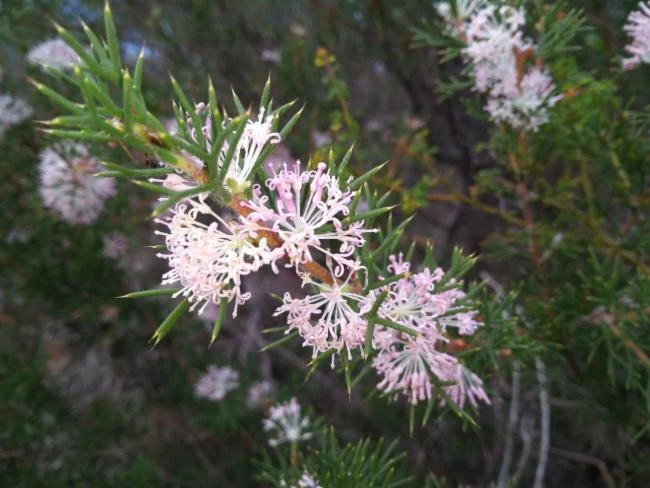Duck-And-Drake-Bush
(Hakea lissocarpha)
Duck-And-Drake-Bush (Hakea lissocarpha)
/
/

Davis, Mick
CC BY 4.0
Image By:
Davis, Mick
Recorded By:
Copyright:
CC BY 4.0
Copyright Notice:
Photo by: Davis, Mick | License Type: CC BY 4.0 | License URL: http://creativecommons.org/licenses/by/4.0/ | Occurence ID: https://www.gbif.org/occurrence/2419396034 | Publisher: Atlas of Living Australia |














Estimated Native Range
Climate Requirements for Gladstone, Missouri
| This Plant | Your Site | Plant Suitability for Your Location | ||
|---|---|---|---|---|
| • Precipitation | 8" - 51" | 39" | Aquatic | Aquatic |
| • High Temp. | 62°F - 101°F | 90°F | Your summer temperatures are normal for this plant. | Excellent |
| • Low Temp. | 28°F - 51°F | 18°F | Your winter temperatures may be too cold for this plant | Too cold |
This plant may not grow well at your location - your precipitation is too high.
Summary
Hakea lissocarpha, commonly known as Duck-And-Drake-Bush, is an evergreen shrub native to the kwongan heathlands, sandplains, and open Eucalyptus woodlands of Western Australia. It is a lignotuberous, dense, and spreading shrub that typically grows to a height of 0.4 to 1.5 meters (1 to 5 ft) with smooth to roughish grey bark. The plant is notable for its pungent foliage and its ability to resprout after fire due to its lignotuber. It blooms from May to September, producing very sweetly scented white-cream, yellow, or pink flowers in racemes located in the leaf axils and on the upper branchlets. The flowers are modest in size but can be quite showy due to their abundance and fragrance.
Duck-And-Drake-Bush is valued for its hardiness, drought and frost tolerance, and its use as a hedging plant or for wildlife habitat in gardens. It is also appreciated for its fragrant flowers and textured bark. In cultivation, it thrives best in full sun to partial shade and requires well-drained soils. It is suitable for xeriscaping and can be used in coastal gardens due to its tolerance to salt spray. While generally low-maintenance, it can be susceptible to root rot in poorly drained soils and may attract aphids or scale insects.CC BY-SA 4.0
Duck-And-Drake-Bush is valued for its hardiness, drought and frost tolerance, and its use as a hedging plant or for wildlife habitat in gardens. It is also appreciated for its fragrant flowers and textured bark. In cultivation, it thrives best in full sun to partial shade and requires well-drained soils. It is suitable for xeriscaping and can be used in coastal gardens due to its tolerance to salt spray. While generally low-maintenance, it can be susceptible to root rot in poorly drained soils and may attract aphids or scale insects.CC BY-SA 4.0
Plant Description
- Plant Type: Shrub
- Height: 2-5 feet
- Width: 1-4 feet
- Growth Rate: Moderate
- Flower Color: White, Pink
- Flowering Season: Spring, Summer
- Leaf Retention: Evergreen
Growth Requirements
- Sun: Full Sun
- Water: Low, Very Low
- Drainage: Fast, Medium
Common Uses
Bee Garden, Bird Garden, Butterfly Garden, Low Maintenance, Potted Plant, Street Planting
Natural Habitat
Native to kwongan heathlands, sandplains, and open Eucalyptus woodlands in Western Australia
Other Names
Common Names: Honeybush
Scientific Names: Hakea lissocarpha, Hakea bipinnatifida, Hakea lissocarpa, Hakea intricata, Hakea petrophiloides, Mercklinia petrophiloides, Mercklinia rosea
GBIF Accepted Name: Hakea lissocarpha R.Br.